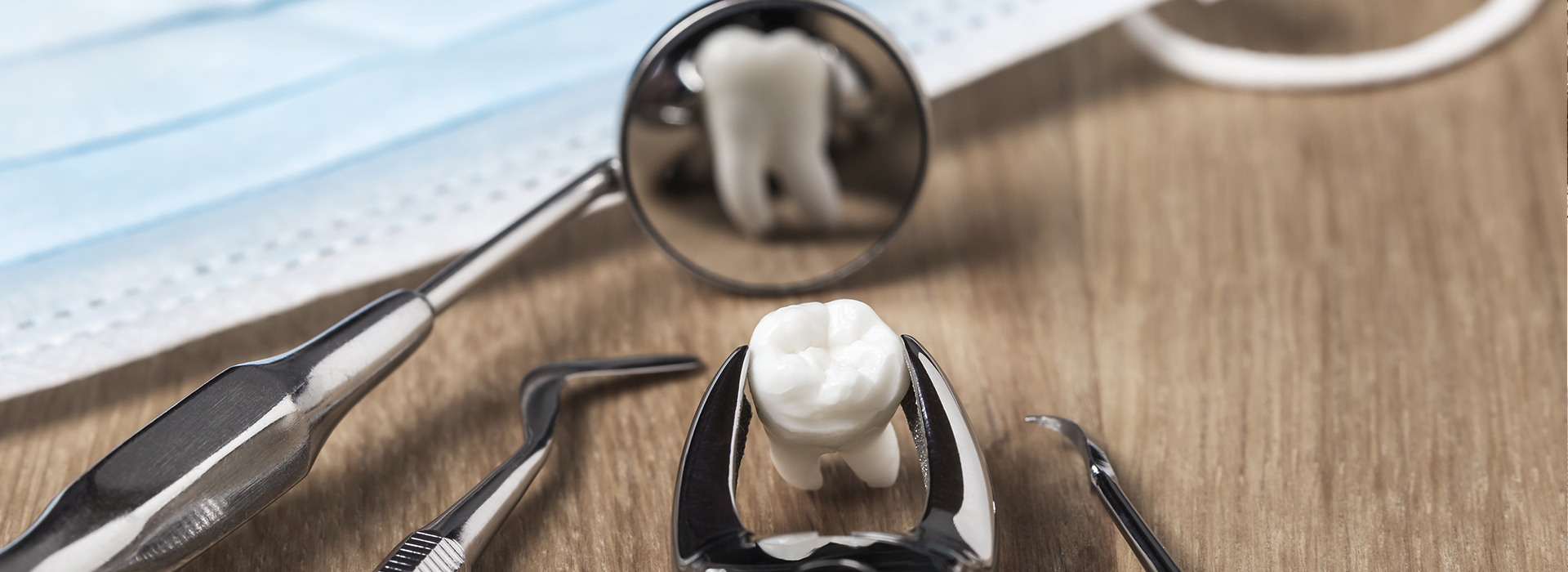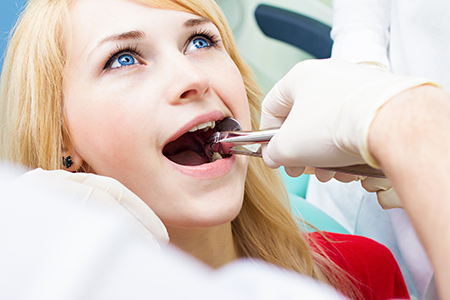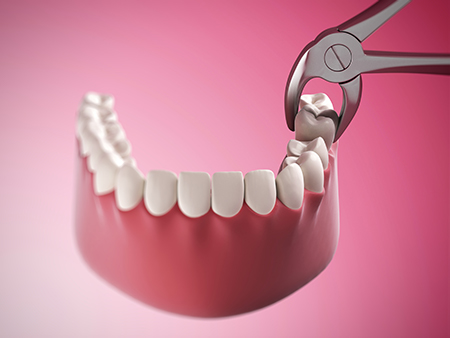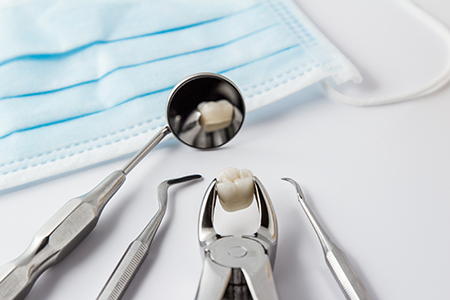New Patients
Existing Patients
New Patients
Existing Patients
New Patients
Existing Patients
New Patients
Existing Patients
New Patients
Existing Patients
New Patients
Existing Patients
New Patients
Existing Patients
New Patients
Existing Patients

Preserving natural teeth is always the first priority, but there are times when removal is the safest path to protect overall oral health. Extractions are recommended when a tooth threatens adjacent teeth, when it cannot be reliably restored, or when it interferes with proper development in a child’s mouth. Making that decision is a careful balance of immediate needs and long-term outcomes.
Common situations that lead to extraction include an over-retained primary tooth that blocks the eruption of its permanent successor, a tooth with extensive decay that cannot be rebuilt, or a tooth so fractured that repair would be unpredictable. Advanced periodontal disease can also undermine the bone and soft tissue support around a tooth, leaving removal as the most sensible option to prevent further loss.
Wisdom teeth are another frequent reason for extraction. Because third molars often lack room to erupt properly, they can become impacted, decay-prone, or painful. In some cases, early removal of problematic wisdom teeth prevents damage to neighboring teeth and reduces the risk of infection later in life. Finally, extractions are sometimes part of orthodontic planning when easing crowding will produce a healthier, more stable bite.
We evaluate each case individually, considering factors like the tooth’s position, the condition of surrounding bone, and the patient’s overall health. Our goal is to preserve function and comfort while minimizing future complications. If extraction is advised, we will explain the reasons, alternatives when available, and the expected outcomes so you understand why it’s the best course.

Before any extraction, we review your medical and dental history and perform a focused exam to determine the safest plan. Imaging—such as digital radiographs—helps us visualize root shape, surrounding bone, and any anatomical considerations that could affect the approach. We’ll also talk through any medications you take and consider medical clearances if there are complicating conditions.
Local anesthesia is used in virtually all routine extractions, and most patients report little to no discomfort during the procedure. For those who experience dental anxiety or who require more complex management, additional sedation options are available and can be discussed at your visit. Our aim is to keep you calm, comfortable, and informed at every step.
For straightforward teeth that are visible in the mouth and have predictable root anatomy, a simple extraction is typically completed quickly and efficiently in the office. When a tooth is broken below the gum line, ankylosed, or impacted beneath bone, a surgical extraction may be required; this can involve small incisions and precise bone removal to access and remove the tooth safely.
In a routine extraction, once the area is numb, the dentist gently loosens any attachments and uses specially designed instruments to remove the tooth. The technique is controlled to protect surrounding bone and soft tissue. After removal, we will place gauze and discuss immediate care to control bleeding and initiate the healing process. Most patients return to normal activities within a few days with proper home care.
Surgical extractions require a more involved approach when a tooth is not easily retrievable. A small incision and modest bone removal may be necessary to create access. If a case is particularly complex, we may coordinate care with an oral and maxillofacial surgeon to ensure the highest level of skill and safety. Throughout, your comfort is prioritized with appropriate anesthesia and, if chosen, sedation support.

Removing a tooth is often only the first step in a broader treatment plan. In many cases, timely planning for replacement preserves chewing function, maintains facial support, and prevents adjacent teeth from shifting. Common options for restoring the space include removable partial dentures, fixed dental bridges, and dental implants—each has distinct advantages depending on your oral health, bone condition, and long-term goals.
Treatment timing matters. Sometimes we recommend allowing a short period of healing before placing a definitive restoration; other times immediate placement or provisional solutions are appropriate. When implants are considered, preserving bone and soft tissue at the time of extraction improves the likelihood of successful implant placement later. We’ll outline the best pathway for your needs and coordinate follow-up care to achieve a lasting result.
Decisions about restoration are personal and clinical. We’ll discuss the pros and cons of each option in plain terms—what to expect during healing, how maintenance differs among choices, and which solutions will best support your oral health for years to come. Our goal is a functional, comfortable smile that integrates seamlessly with your daily life.
After an extraction, following simple, evidence-based precautions speeds recovery and reduces complications. Apply steady pressure with the provided gauze to help form a stable clot, and avoid actions that could dislodge it—such as vigorous rinsing, spitting, or using a straw—until the site begins to seal. Protect your lips, cheeks, and tongue while local anesthetic is still in effect to prevent accidental injury.
Medication instructions should be followed closely. If antibiotics have been prescribed, complete the course as directed. For discomfort, over-the-counter or prescription analgesics can be effective; taking the first dose before the anesthetic wears off often improves comfort. Use ice intermittently during the first 24 hours to manage swelling, and limit strenuous activity for the initial recovery period.
Diet and oral hygiene are important contributors to healing. Choose soft, cool foods at first and stay well-hydrated; avoid hot, spicy, or carbonated beverages in the immediate days following surgery. Gentle brushing around the extraction area and, when advised, mild saline rinses help keep the mouth clean without disrupting the healing clot. Attend any scheduled follow-up so we can monitor progress and remove sutures if present.

Choosing a provider for extractions means trusting a team that blends clinical skill with clear communication and individualized planning. Our clinicians prioritize conservative care, only recommending removal when it best serves a patient’s overall oral health. When extraction is necessary, we take steps to protect surrounding structures, reduce discomfort, and set the stage for a predictable recovery and restoration.
We use current diagnostic tools and follow contemporary protocols to identify risks, minimize complications, and coordinate with specialists when cases require advanced surgical care. Patients benefit from an approach that emphasizes comfort, safety, and long-term function—helping you get back to the things that matter with confidence in your dental health.
If you have questions about whether an extraction is right for you, or if you’d like to learn more about options for replacing a missing tooth, we’re here to help. Contact us to discuss your situation in detail and explore the treatment pathway that best supports a healthy, functional smile.

The most common reasons for tooth loss include advanced periodontal disease, extensive tooth decay, and facial trauma. According to statistics, gum disease is responsible for close to 70% of tooth loss in adults. Although less frequent than the preceding three reasons, it should also be noted that specific diseases, drugs, smoking, and poor nutrition contribute to the risk of tooth loss.
The Centers for Disease Control and Prevention report that in the United States, an average of 12 teeth (including the wisdom teeth) are lost by the age of 50. Also, 26% of adults between 65 and 74 years of age have lost all their teeth.
Every patient and every situation is different. However, when a tooth and the surrounding tissues are numbed with a local anesthetic, you should only expect to feel a bit of pressure, but no pain as the tooth is being loosened from the surrounding tissues and extracted. For patients who are apprehensive and for some surgical extractions, our office will discuss our options in dental sedation to provide further relaxation and reduce any sense of discomfort.
While it's normal to feel some tenderness and swelling following an extraction, the degree of these sensations can vary. It mostly depends on the complexity of the extraction and the body's response to the procedure. We'll recommend or prescribe the appropriate pain medication to help ensure your comfort and give you specific instructions for maximum effectiveness and safety.
Typically, the recovery period following a simple extraction is shorter than a surgical extraction. However, a patient's overall health, habits, the size and location of the tooth, and other variables can influence recovery and healing. To speed up the recovery and avoid any complications, patients must follow the given at-home instructions diligently. We'll carefully review what to expect following your procedure and go over your post-op instructions.
Smoking interferes with blood clot formation, which is an essential first step in the healing process. Blood clot formation not only provides a protective layer to cover the underlying exposed bone and nerve endings, but it also supports the growth of new tissue. Cigarette smoke also contains chemical toxins that can disrupt the healing process and lead to problems such as continued inflammation, infection, or dry socket.
In a very small percentage of cases, a condition known as dry socket can develop in the aftermath of a dental extraction. This painful condition can arise when the blood clot in the extraction site doesn't form properly or gets dislodged. With dry socket, you may experience throbbing pain and symptoms such as bad breath and an unpleasant taste in your mouth. As skilled providers of care, our office will provide immediate treatment to alleviate your discomfort and promote healing.
The last teeth in your mouth to develop, wisdom teeth often do not have enough room to fully erupt or may be positioned in the wrong direction. These issues can affect your dental health as well as overall wellbeing. While some individuals never develop all their wisdom teeth, and a few have sufficient space for them, there are many people with partially or fully impacted third molars. Our office will monitor the development, position, and health of your wisdom teeth and will advise you if and when extractions are indicated.
After a tooth is removed, bone-grafting material is sometimes placed in the socket to promote healing and encourage new bone development. This procedure is often performed to support the eventual and successful placement of a dental implant.
At the office of Artistic Family Dental, we strive to make dental care affordable and accessible. Depending on the type or complexity of the extraction and other variables, the cost of the procedure can vary. Based on our diagnostic findings, our office will inform you of the healthiest choices in care, explain the fees, discuss insurance coverage, and explain your payment options.
Many dental plans offer some level of coverage for tooth extractions. We'll advise you if your plan covers the full cost of the procedure and if there is any out-of-pocket expense. Our business office will work with you to maximize your insurance benefits as much as possible while helping you minimize any out-of-pocket expenses.
Preserving a natural tooth is always the first goal, but extraction becomes necessary when a tooth compromises oral health. Typical reasons include extensive decay that cannot be restored, severe fracture, or advanced periodontal disease that has damaged supporting bone. We also consider extractions when a retained primary tooth blocks the eruption of a permanent tooth or when orthodontic treatment requires space.
Third molars frequently lack room to erupt properly and can become impacted, infected, or harmful to neighboring teeth. Early removal may prevent future pain, decay, or damage to adjacent teeth when eruption patterns suggest trouble. Your dentist will use imaging and clinical evaluation to determine if monitoring or removal is the best plan.
Before an extraction we review your medical history, current medications, and any conditions that could affect healing. Digital radiographs or CBCT scans help us visualize root anatomy and nearby structures that influence the approach. If you take blood thinners or have cardiac or bleeding conditions, we coordinate with your physician to plan safe management.
If you plan to use sedation, you may be asked to avoid eating or drinking for several hours and to arrange transportation home. Wear comfortable clothing and let us know about allergies or recent illnesses on the day of the procedure. At Artistic Family Dental we will review post-operative instructions ahead of time so you know what to expect and can prepare soft foods and supplies.
Routine extractions typically begin with local anesthesia to numb the area and ensure minimal discomfort. Once numb, the dentist gently loosens the tooth and uses specially designed instruments to remove it while protecting surrounding bone and tissue. The process is controlled and often completed quickly for teeth with straightforward root anatomy.
After removal we place gauze to help a clot form, provide instructions to control bleeding, and discuss pain management. Sutures are used when necessary and are removed or monitored at a follow-up visit. Most patients return to normal activities within a few days when they follow recommended care.
Surgical extractions are used when a tooth cannot be removed intact, such as when it is broken at the gumline or impacted beneath bone. This approach may involve a small incision, careful removal of bone, and sectioning the tooth to retrieve it safely. Surgical cases require more time and often additional local or sedative anesthesia to maintain comfort.
For particularly complex cases we may refer or coordinate care with an oral and maxillofacial surgeon to ensure the highest level of surgical expertise. Your treatment plan will explain the rationale for a surgical approach and set realistic expectations for recovery and follow-up. With appropriate technique and post‑operative care, most surgical extractions heal predictably.
No, wisdom teeth are not always removed; the decision depends on eruption patterns, symptoms, and the risk they pose to adjacent teeth. If third molars are fully erupted, functional, and can be kept clean, monitoring may be appropriate. When impaction, recurrent infections, decay, or crowding are present, removal is often recommended to prevent future problems.
Imaging helps identify impacted roots and their relation to nerves or sinuses, which influences timing and technique. Some patients benefit from early removal to reduce the chance of more complicated surgery later in life. We individualize the recommendation based on your oral health and long‑term goals.
Local anesthesia is used in nearly all extractions to block pain at the site, but additional sedation can help patients who are anxious or undergoing complex procedures. Options commonly include nitrous oxide for mild relaxation, oral sedatives for moderate relief, and intravenous sedation for deeper comfort when indicated. Each method has different preparation and monitoring requirements, and our team will recommend the safest choice for your needs.
We review your medical history and current medications to select an appropriate sedation plan and ensure safe monitoring during the procedure. Some sedative options require fasting and a responsible adult to drive you home afterward. Discuss sedation preferences and concerns during your visit so we can tailor care to keep you calm and comfortable.
The first 24 to 48 hours are critical for clot formation and control of bleeding and swelling. You can expect some bleeding, mild to moderate discomfort, and swelling that peaks within the first day or two. Applying ice intermittently and following analgesic instructions helps manage symptoms while the tissues begin to heal.
Stick to soft foods, avoid vigorous rinsing, and be careful when brushing near the surgical site to protect the clot. Avoid smoking, straws, and strenuous activity for several days as these actions increase the risk of complications. If you experience excessive bleeding, severe pain that worsens after a few days, or signs of infection, contact the office promptly.
A dry socket occurs when the blood clot is dislodged or fails to form, exposing bone and nerve endings and causing severe pain. To reduce this risk, avoid actions that create suction or disturb the site, such as using a straw, spitting forcefully, or smoking. Follow the gauze and oral hygiene instructions closely and take medications as directed to support proper healing.
If your clinician prescribes antibiotics or a medicated dressing, use them exactly as directed to lower infection risk. Attend any scheduled follow-up so we can monitor healing and intervene early if a complication arises. Persistent or worsening pain, fever, or unusual drainage should prompt immediate contact with the dental team.
Replacement timing depends on the extraction site, presence of infection, bone quality, and the restorative option you choose. Some patients are candidates for immediate provisional restorations or immediate implant placement, which can preserve bone and soft tissue. In other cases, a period of healing of several weeks to months improves outcomes before placing a definitive restoration.
Common replacement options include dental implants, fixed bridges, and removable partial dentures, each with specific benefits and maintenance needs. When implants are planned, we assess bone volume and may recommend bone grafting or staged treatment to achieve predictable results. Your dentist will outline the timing, sequence, and aftercare for the solution that best supports function and long‑term health.
Artistic Family Dental combines clinical expertise, evidence-based protocols, and modern diagnostic tools to plan extractions that protect surrounding structures and long-term oral health. Our team emphasizes conservative decision-making, clear communication, and individualized treatment pathways to minimize risks and support predictable recovery. When a surgical approach is needed, we coordinate with specialists to ensure complex cases receive appropriate care.
We prioritize patient comfort with effective anesthesia and sedation options and provide detailed aftercare guidance to support smooth healing. Follow-up visits ensure sutures are managed and that restoration planning proceeds when appropriate. If you have questions or would like an evaluation for extractions and restorative options, contact the office to schedule a consultation.

Ready to schedule your next appointment or learn more about our services?
Our friendly team is here to make it easy. Whether you’d like to call, email, or use our convenient online form, we’ll help you find the right time and answer any questions you have. Don’t wait to take the next step toward a healthier, more confident smile—contact Artistic Family Dental today and experience the difference genuine, personalized care can make.